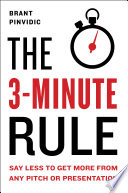

In a world where attention spans are dwindling, the ability to communicate ideas concisely is invaluable. The 3-Minute Rule emphasizes the importance of distilling complex ideas into their essence. This skill is not just about brevity; it's about clarity. When you can convey your message in three minutes or less, you respect your audience's time and increase the likelihood of engagement. This idea extends beyond verbal communication to written forms as well, encouraging professionals to craft emails, presentations, and proposals that are to the point. By practicing conciseness, individuals can improve their persuasion skills, making their arguments more compelling and memorable.
Continue readingThe book highlights the necessity of engaging your audience from the very beginning of your communication. The first few seconds are crucial in capturing attention. This involves using storytelling techniques, relatable anecdotes, or intriguing questions to draw listeners in. Engaging your audience is not merely about delivering information but about creating a connection. The 3-Minute Rule provides strategies for understanding your audience's needs and interests, allowing you to tailor your message accordingly. This approach fosters a two-way dialogue, where the audience feels involved and valued, enhancing the overall impact of your communication.
Continue readingEffective communication requires a clear structure. The 3-Minute Rule advocates for a straightforward framework that includes an introduction, a body that presents key points, and a conclusion that reinforces the main message. This structure helps listeners follow along and retain information. The book suggests using the 'Problem-Solution-Benefit' model, where you outline a problem, propose a solution, and explain the benefits of that solution. This logical flow not only makes your message easier to understand but also increases its persuasiveness, as it clearly lays out the rationale behind your ideas.
Continue readingLike any other skill, effective communication requires practice. The 3-Minute Rule stresses the importance of rehearsing your message to ensure fluency and confidence. This practice should not only focus on the content but also on delivery aspects such as tone, pace, and body language. The book suggests recording yourself to identify areas for improvement, as well as seeking feedback from others. Regular practice allows you to refine your message, making it more impactful over time. Moreover, the more you practice, the more comfortable you become with spontaneous speaking, enabling you to adapt your message on the fly when necessary.
Continue readingCommunication is not one-size-fits-all; different contexts require different approaches. The 3-Minute Rule encourages readers to be adaptable in their communication style depending on the audience, setting, and purpose. Whether you are pitching to investors, presenting to colleagues, or speaking at a conference, the book provides insights on how to adjust your message to fit the situation. This adaptability enhances your effectiveness as a communicator, as it shows that you are considerate of your audience's preferences and expectations. Understanding the context also allows you to anticipate questions or concerns, making your communication more robust.
Continue readingVisual aids can enhance communication when used appropriately. The 3-Minute Rule discusses how to integrate visuals into your presentations to support your message rather than distract from it. Effective visuals should be simple, relevant, and easy to understand. The book advises against cluttered slides or overly complex graphics that can confuse the audience. Instead, visuals should serve to reinforce key points and provide clarity. By complementing verbal communication with appropriate visuals, speakers can enhance understanding and retention, making their message more impactful.
Continue readingFeedback is a critical component of effective communication. The 3-Minute Rule emphasizes the importance of seeking and incorporating feedback to improve your communication skills. This can come from peers, mentors, or even audience members after a presentation. Understanding how your message is received allows you to identify strengths and weaknesses in your delivery and content. The book encourages a mindset of continuous improvement, where feedback is viewed as a valuable tool for growth. By actively seeking feedback and making adjustments, you can enhance your communication effectiveness over time.
Continue reading